Time for Ume: Tea in July
July 18th is the start of the lunar 6th month, Tsuitachi, 朔, New moon, and bears the old name Mi-na-zuki, 水無月, Water-no-month, which refers to the dry period after the end of the rainy season, Tsuyu, 梅雨, Apricot-rain; the Kanji are also, and more literally, read Bai-u. Tsuyu, méiyǔ in China, refers to the season when the fruits of (ume) Prunus mume ripen. The word tsuyu has no connection with the reading of the Kanji for the words bai, ume, 梅, a kind of Japanese apricot, and u, ame, 雨, rain. The word tsuyu may be derived from the classical Japanese verb tsuyu, 熟ゆ, to become ripe, referring to the ume.
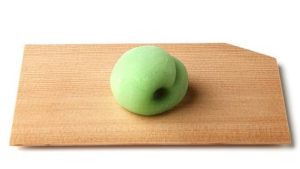

Toko-no-ma, 床の間, floor-’s-room; kake-mono, 掛物, hang-thing, calligraphy, Zui-ryū, 随流, follow-flow. Candlestick, Ori-be-yaki, 織部焼, Weave-guild-fired. Tsuri-hana-ire, 釣花入れ, suspend-flower-receptacle, dried fukube, 瓢, gourd. Waki-doko, 脇床, side-floor; porcelain figure of Sen no Rikyū, 千利休, Thousand Rich-quit. Kō-gō, 香合, incense-gather, take-ikada, 竹筏, bamboo-raft, on a pack papers, kami-kama-shiki, 紙釜敷, paper-kettle-spread.
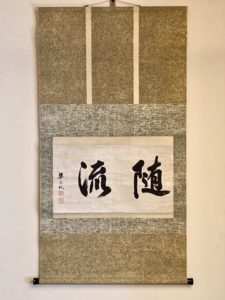
The calligrapher, Liang Wen–man, 梁文玩, Beam Literary-take pleasure, was Chinese, and may have practiced Zen at Ō-baku-san Man-puku-ji, 黄檗山萬福寺, Yellow-cork-mountain Ten thousand-fortune-temple, in Uji. The temple was founded in 1661 by In-gen, 隠元, Conceal-origin, a Chinese priest who introduced Ōbaku sect Zen practice.
The scroll mounting is made of momi-gami, 揉紙, rumpled-paper, which is paper that has been painted, and then crumpled, creating a random pattern of wrinkles. This kind of paper is to emulate the painted paper jackets worn by Buddhist priests, that take on a similar appearance after years of wear. Such no-longer wearable paper jackets were treasured and used variously, including as part of the mountings for Buddhist scrolls. As the look of the paper became popular, the supply of disused paper jackets was very limited, so that artists created paper that had a similar appearance. In time, this paper became expensive to acquire.

Tsuri-hana-ire, 釣花入, suspend-flower-receptacle, dried fukube, 瓢, gourd; diam. 8 sun kane-jaku. Take ji-zai, 竹自在, bamboo self-exist, hanger; L. 2 shaku kane-jaku or 16 sun kujira-jaku.
It is preferred to have the flower below the center of the hon-shi, 本紙, true-paper, of the kakemono. Rikyū set the location of the hana-kugi, 花釘, flower-hook, in the toko-bashira, 床柱, floor-post, at 3.35 shaku kane-jaku, above the floor. This location is below the mu-sō kugi, 無双釘, no-pair-hook, that is in the exact center of the back wall of the tokonoma.
There are exceptions, such as the hook that Sō-tan, 宗旦, Sect-dawn, put in the ko–kabe, 小壁, small-wall, lintel at the front of the tokonoma, from which he hung a bamboo hana-ire in the guise of a boat.

The classic Japanese traditional makeup is called oshiroi, 白粉, white-powder, that contained mercury oxide which is highly toxic – causing lead poisoning. It was brought from China to Japan in the 7th century, and was worn by men and women. In the 20th century, oshiroi’s toxicity was banned, and other materials are used to fabricate white makeup. The Japanese word for interesting, amusing, etc, is omo-shiroi, 面白い, face-white, is derived from oshiroi.
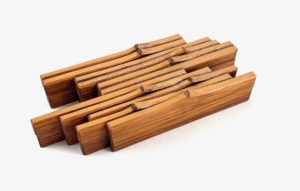
In Japan, sandalwood is so closely related to Buddhism, that for some people the incense itself is regarded as sacred. The body of the Buddha was said to have smelled of sandalwood. The fuel for his cremation fire was sandalwood. The Latin name for white sandalwood is Santalum album. In spite of its spelling including santa, its etymology has nothing to do with ‘saintly’, but rather it is related to Sanskrit candrah, shining, glowing, and is cognate with Latin candere, to shine, glow, which is from its being burned as incense.
Because of the importance of the reverence for departed ancestors, incense is often burned during memorials. This is especially true in the observance of O-bon, お盆, Hon.-tray, memorial rites for spirits returning to their homes in July and August. Obon in July is second only to New Year celebrations in returning ‘home’ when families get together amidst heavy travel throughout the three-day rites.

Incense has great importance during Obon, as it is primarily a Buddhist rite. Special incense is made, including spiral sen-kō, 線香, stick-incense, as it can burn for an extended period of time. The traditional incense for Chanoyu is byaku-dan, 白檀, white-sandalwood, with the fu-ro, 風炉, wind-hearth, in the warm half of the year, and neri-kō, 練香, kneaded-incense, is a damp blend of aromatics with the ro, 炉, hearth, in the cold half of the year.
The Japanese people love incense, o-kō, お香, and they burn incense for many occasions. There are countless varieties of the incense, from quite inexpensive, often for daily use, to costly treasured woods and blends. A special incense for Buddhist mourning observances created by Shōyeidō Company is called Shichi-ya-kō, 七夜香, Seven-night-incense. It is a coil, uzu-maki sen-kō, 渦巻線香, spiral-roll stick-incense, (pictured above) that is meant to hang, as many incense coils are used in Buddhist temples, especially in China. It is an appropriate incense to burn during Obon observances. In mourning rites, incense is burned from the wake of the deceased to the 49th day, which is a period of seven weeks.

Kō-gō, 香合, incense-gather; ko-ma kō-gō, 独楽香合, solitary-pleasure incense-gather, multi-color lacquered covered box with incised decoration, choice of Gen-gen-sai, 玄々斎, Mystery-mystery-abstain, XI Oiemoto, Urasenke.
According to Urasenke tradition, this type of kō-gō is used to hold byaku-dan, 白檀, white-sandalwood, incense. The design of the incense container is modeled on ancient Viet Nam lacquer techniques.
On the 5th of July, is the grand memorial Tea gathering of Sei-chū En-nō Mu-gen-ki, 精中圓能無限忌, Spirit-mid Circle-skill No-limit-memorial, Ura-sen-ke, 裏千家, Inner-thousand-family, Kyōto. Memorials honoring Seichū / Gen-gen-sai, 玄々斎, Mystery-mystery-abstain, 11th Oiemoto; Ennō / En-nō-sai, 円能斎, Circle-skill-abstain; 13th Oiemoto; Mugen / Tan-tan-sai, 淡々斎, Light-light-abstain; 14th Oiemoto.
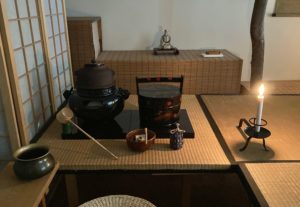

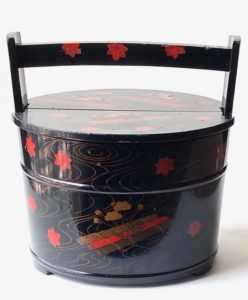



Leading up to Obon, is a much-celebrated event, Tana-bata, 七夕, Seven-night, when poems and prayers are offered to two stars that are seen as lovers with major challenges. Tanabata is a lunar event, but is more popularly observed on July 7th, whereas, the traditional seventh night of the seventh moon, a half-moon, is observed on August 22nd in 2023. Tanabata is preparation for Obon that occurs seven days later.

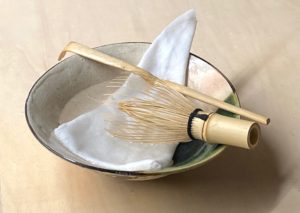

Hira-ja-wan, 平茶碗, wide-tea-bowl, ceramic bowl with green glaze pool and run, and black glaze design of asa-gao, 朝顔, morning-face, in the style of O-gata Ken-zan, 尾形乾山, Tail-form Northwest-mountain, Ori-be yaki, 織部焼, Weave-guild fired, unsigned; diam. 5.1 sun kane-jaku. The chawan is prepared for a presentation called arai-ja-kin, 荒茶巾, rough-tea-cloth, when the hemp chakin is placed in the chawan that is half-filled with water, together with the bamboo cha-sen, 茶筅, tea-whisk, and the bamboo cha-shaku, 茶杓, tea-scoop. The chakin is taken from the bowl, folded in half, and wrung once over the water, and allowed to drip making a ‘rough’ sound. The chakin is wrung over the ken-sui, 建水, build-water, and folded in the usual manner. This style of chawan, and procedure with the chakin is enacted in hot weather to give a ‘cooling effect’.

Having water in the chawan, and the dripping sound may evoke various aspects. The sea. Hemp fabric is woven by Ama-terasu, 天照, Heaven-brighten, the Shintō sun goddess. The chashaku is somewhat like a bridge over water. The dripping chakin, and the splashing of the chasen is turbulent, arai. When the chasen is examined, it is rotated like the turning of the heavens.



Left: magpie, kasasagi, 鵲. Right: design of Ya-ta-garasu, 八咫烏, Eight-span-crow.
The teshoku is black, has three legs, and is closely associated with fire, which is similar to the sacred crow related to Ama-terasu, 天照, Heaven-brightener, the Shintō sun goddess. The sun is symbolized by the Ya-ta-karasu, 八咫烏, Eight-span-crow, which is black, has three legs, and its connection with fire is obviously related to the sun. The magpie is black and white, and is a member of the Corvus family, which includes crows. It is interesting to note that the black teshoku with its candle, is a little like the black and white magpie.

Ho-tei, 布袋, cloth-bag, is one of the most beloved and revered Buddhist monks. The tenth-century Chinese Zen monk Budai, known in Japan as Hotei, was believed to have been the reincarnation of Maitreya, the Buddha of the future, and was decreed so on the 6th day of the 6th month of the lunar calendar. Hotei is one of the Shichi–fuku–jin, 七福神, Seven-fortune-gods, who is of Hindu, Buddhist, Chinese, and Japanese origins.

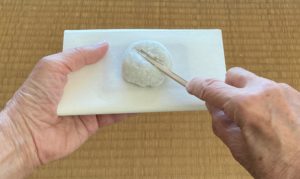
This kind of mochi sweet is one of the most popular and familiar sweets in Japan, and there are countless variations of the filling and the wrapping. The original Kanji for the name dai-fuku was dai, 大腹, big-belly, which would be most appropriate for Hotei. But it was thought that such a name could hinder sales. Big bellies are great attributes of abundance for gods, but not for ordinary people.
In China, ‘Lord Maitreya’ is known as the ‘hemp bag bonze’; a bonze is a Buddhist monk, and Maitreya is often pictured as a bonze, Budai in China, and Hotei in Japan. The word ‘bonze’ comes from French bonze, from Portuguese bonzo, from Japanese bon-zō, 凡僧, ordinary-Buddhist monk. There is an interesting wordplay on ho-tei, 補訂, supply-resolve, revision.
Hotei’s original Chinese name was Qì cǐ, 契此, Pledge-this, in Japanese, Kai-shi; also called Shaku-kai-shi, 釈契此, Explain-pledge-this. Another word that is connected to Hotei is kai-shi, 戒師, precept-master, open to the Law of the Buddha.

Yōkan is a sweet that is made of cooked beans in sugar, and blended with agar so that it can last for a long period of time, and is symbolic of the ‘Past’. It is identified as ‘sheep’ as in its original Chinese form was a savory dish made with sheep’s liver. Although similar in color, Buddhists do not eat meat, so the sweet is symbolic of a life not taken.

When offering a sweet to a guest, it could be placed on a folded sheet or two of kaishi. The folded sheet of kaishi is re-folded so that the two halves are offset. For a celebratory occasion the top layer is to the right of the bottom layer, whereas for a sad occasion, the top layer is to the left of the bottom layer. The off-set folded paper creates six corners, and the number six, roku, 六, is symbolic of Infinity in Time. It should be remembered that the preferred length of the kuromoji pick is six sun kane-jaku.
In Chanoyu, the word kaishi is a homonym of kai-shi, 懐石, heart-paper, the pack of white papers used to hold a sweet to be eaten before drinking tea. The kaishi is comprised of 30 sheets of paper, and there are 30 chapters in the Heart Sutra, Han-nya-shin-kyō, 般若心経, Carry-young-heart-sutra. Maitreya is believed to have transformed Shakyamuni’s teaching into a condensed form readily accessible to common people, in the form of the Heart Sutra and other Buddhist texts. It might be understood that having the pack of kaishi near the heart, is in its way cherishing the teachings of the Buddha through Maitreya, Miroku, and Hotei.



Left: shi-fuku, 仕覆, serve-cover, silk bag covering a cha-ire, 茶入, tea-receptacle. Right: Ō-tsu bukuro, 大津袋, Great-port bag, silk crêpe covering a Rikyū-gata chū-natsume, -形中棗, form middle-jujube, ovoid, black-lacquered, turned wood covered container.
A cloth bag, such as Hotei’s, in Japanese is fukuro, 袋. It is interesting to note that the word includes the word fuku, which is a homonym of fuku, 福, fortune. There are several significant cloth bags used in Chanoyu, including a type of bag called shi-fuku, 仕覆, serve-cover, which are fitted coverings for cha-ire, 茶入, tea-receptacle, and other utensils. The shifuku is tailored to fit the object, whereas a fukuro is a cloth that is a covering of gathered fabric and tied with a cord bow. One exceptional variation is the Ō-tsu bukuro, 大津袋, Great-port bag, which covers a Rikyū-gata chū-natsume, 利休形中棗, middle-jujube. The Ōtsu bukuro is modelled on a rice bag from the Ōtsu area that is known for its rice production. The bag is made of purple silk crêpe fabric the is fitted to the natsume, and with its pointed ends tied in a bow.

July 22, 2023, is the lunar 6th month 6th day. On this date in the 10th century, the wise Buddhist monk, Ho-tei, 布袋, Cloth-bag, was deemed a reincarnation of Maitreya, who in Japanese is Mi-roku Bo-satsu, 弥勒菩薩, Increase-rein Grass-buddha.
Hotei is the god of fortune, guardian of children, patron of diviners and barmen, and also the god of popularity. He is depicted as a fat, smiling, bald man with a curly moustache. He always appears half-naked, as his clothes are not wide enough to cover his enormous belly. Hotei was a Zen priest, but his appearance and some of his actions were against the temple’s moral code: his appearance made him look like quite a mischievous person, and he had no fixed place to sleep. He carried a bag on his shoulders which was loaded with fortunes for those who believe in his virtues.
Hotei’s traits and virtue are contentment, magnanimous, and happiness. Hotei’s original Chinese name was Kaishi, and according to legend, he died in March 916. The Japanese began to strongly believe in Hotei during the Edo era. The reason why the Japanese have such great respect for this god, comes from a legend that says that before Zen Buddhism arrived to Japan, an alternative Buddhist thought was extended by a priest of dubious aesthetic, who was a manifestation of Miroku Bosatsu. Miroku was the patron of those who could not be saved by the beliefs of Buddhism, and Hotei was later perceived and accepted by the Japanese as a second Miroku.
July 30th is Do-yō no Ushi, 土用の牛, Earth-work ’s Ox, is the start of 18-day period at the end of the lunar Ox month, when certain works are avoided or encouraged. On the day of the Ox, Ushi, the Japanese people have the custom of eating eel as a nourishing tonic against the summer heat. The Japanese eel is called unagi, 鰻, eel, esp. Anguilla japonica. In fact, eel contains many ingredients that are effective in recovering from fatigue and increasing appetite, such as vitamin A and vitamin B group.

Eating eel, unagi, 鰻, is popular throughout the year, and is especially enjoyed in summer. Because of its oily nature, it is prepared specially to remove the oiliness for kai-seki, 懐石, belly-stone, for a Cha-ji, 茶事, tea-matter. However, the usual and much enjoyed manner in which it is commonly prepared, kaba-yaki, 蒲焼, bullrush-fired, is grilled on a skewer dipped in a sauce, served on rice, una–don, 鰻丼, eel-bowl. No matter how sumptuous, its oiliness is inappropriate for Chanoyu.
The flavor of eel is enhanced with a sprig of san-shō, 山椒, mountain-pepper, Japanese pepper, species of Sichuan pepper, (Zanthoxylum piperitum); Japanese prickly ash. It is said that eel is a perfect ingredient to prevent summer fatigue. The 8th century Buddhist priest, Kū-kai, 空海, Empty-sea, who founded the Shin-gon-shū, 真言宗, True-word-sect, of Buddhism in Japan, espoused eating eels in summer for its healthful benefits.
Another variety of eel in Japan is the hamo, 鱧, conger eel, daggertooth pike conger, Muraenesox cinereus. Because of its many small bones, custom has the long narrow flat body flesh with very thin cuts to the skin; hone-kiri, 骨切り, bone-cut.

The fish is par-boiled, yu-biki, 湯引き, hot water-draw, which removes the oil, so that it may be included in dishes of a Chaji’s kai-seki, 懐紙, heart-stone. An example, pictured here, is a ni-mono, 煮物, boil-thing.

The night of July 31st, is the Sen-nichi mairi, 千日詣, Thousand-day temple visit, Atago-yama, 愛宕山, Love-cave-mountain, northwest of Kyōto. Pilgrims climb the sacred mountain to pray at Atago Tai-shi, 愛宕大社, Love-cave Great-shrine, from sunset on July 31st to sunrise on August 1st. The climb, which includes stone stairs and paths, takes about five hours to reach the shrine. If this is accomplished, one will have protection from fire and mishaps for one thousand days. The Shintō shrine was founded in 700, and is the highest shrine in the Kyōto area. Atago Gon-gen, 愛宕権現, is a Japanese kami believed to be the local avatar of Buddhist bodhisattva Ji-zō Bo-satsu, 地蔵菩薩, Earth-keep Grass-buddha. Kyōto’s Atago Jinja is the main shrine of the practice of Shu-gen-dō, 修験道, discipline-test-way, a combination of Shintō and Buddhism, of which there are more than 900 branches around Japan.
Tanabata and Obon are lunar events, and will be detailed further in the upcoming August Chanoyu Decoded. For past Tanabata articles see also: Tea in August and Tanabata and Taoism

